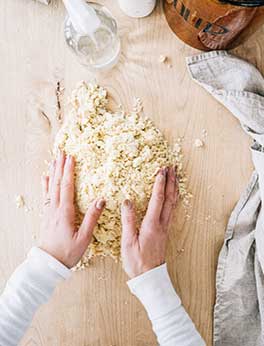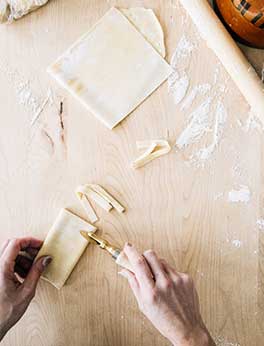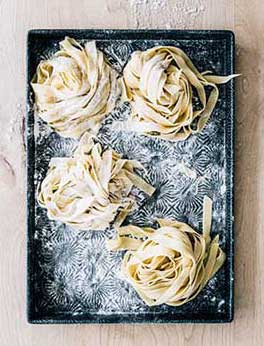Making your own pasta can seem intimidating . . . and challenging. But rest assured—it really isn’t! Make it once and you’ll never go back to store-bought pasta again. The taste of fresh pasta is incomparable. Plus, you’ll be proud to say you made it yourself.
It’s the perfect project for cold January weekends when you feel like relaxing and cooking in the warmth of your home. Play some music, pour yourself a glass of wine, and follow our guide on how to make easy homemade pasta.
Preparing the pasta: 15 to 25 minutes
Resting time: 1 hour
Shaping the pasta: between 30 and 60 minutes, depending on the shape of the pasta and your skill level
Yields: 4 portions, 454 g (1 lb)
 The first step consists of placing the flour and salt on a clean work surface (for the traditional method) or in a bowl (for the stand mixer method). Dig a deep, large well (15 to 20 cm, or 6 to 8 inches in diameter) in the centre of the flour. Place the eggs and oil in the well.
For the traditional method: Using a fork, whisk the eggs and slowly incorporate them into the flour. Be careful to keep the mixture in the centre of the well, to avoid having eggs spill out onto your work surface.
When the dough gets too hard to mix with the fork, use your fingers, and then your hands. Work in as much flour as the dough is able to absorb. Continue to mix until small bits of dough begin to detach themselves from your ball.
For the stand mixer or food processer method: This step can also be done in a food processer or stand mixer equipped with a paddle. The result will be dough with a grainier texture, kind of like sand. If the dough is too sticky, add flour, 15 ml (1 tbsp.) at a time, or until the dough breaks off in large clumps. Inversely, if the dough is too dry, add 15 ml (1 tbsp.) of water until desired consistency is obtained
The first step consists of placing the flour and salt on a clean work surface (for the traditional method) or in a bowl (for the stand mixer method). Dig a deep, large well (15 to 20 cm, or 6 to 8 inches in diameter) in the centre of the flour. Place the eggs and oil in the well.
For the traditional method: Using a fork, whisk the eggs and slowly incorporate them into the flour. Be careful to keep the mixture in the centre of the well, to avoid having eggs spill out onto your work surface.
When the dough gets too hard to mix with the fork, use your fingers, and then your hands. Work in as much flour as the dough is able to absorb. Continue to mix until small bits of dough begin to detach themselves from your ball.
For the stand mixer or food processer method: This step can also be done in a food processer or stand mixer equipped with a paddle. The result will be dough with a grainier texture, kind of like sand. If the dough is too sticky, add flour, 15 ml (1 tbsp.) at a time, or until the dough breaks off in large clumps. Inversely, if the dough is too dry, add 15 ml (1 tbsp.) of water until desired consistency is obtained
 On a lightly floured surface, flatten the dough and knead from the centre to the outer sides with the palm of your hand. Fold the dough in half, give it a quarter turn, and repeat. Knead for approximately 10 minutes, or until the dough is smooth and homogenous. The dough should no longer be sticky and should bounce back when pressed.
Pro tip
The humidity level of the flour and size of the eggs can vary significantly. That’s why you need to be in tune with the dough and adjust as needed. The dough calls the shots!
On a lightly floured surface, flatten the dough and knead from the centre to the outer sides with the palm of your hand. Fold the dough in half, give it a quarter turn, and repeat. Knead for approximately 10 minutes, or until the dough is smooth and homogenous. The dough should no longer be sticky and should bounce back when pressed.
Pro tip
The humidity level of the flour and size of the eggs can vary significantly. That’s why you need to be in tune with the dough and adjust as needed. The dough calls the shots!
 It’s time for everyone’s favourite step—shaping the pasta! Start by cutting the dough into 8 pieces. Always make sure to cover the dough you’re not working with to prevent it from drying out.
Using a rolling pin, roll the dough out. This step is even easier when using a pasta maker. Continue rolling until the dough is about 1.5 mm thick (about as thick as a 10-cent coin). Remember to sprinkle your dough and work surface regularly with flour to prevent the dough from sticking.
The easiest shape to make (especially if this is your first time making pasta) is linguini. Fold the dough a few times over in order to form a large roll, then cut strips that are 0.5 cm (1/4 inch) thick. Place the strips on a floured surface as you go. For an optimal texture, let your linguini rest 30 to 60 minutes before cooking.
It’s time for everyone’s favourite step—shaping the pasta! Start by cutting the dough into 8 pieces. Always make sure to cover the dough you’re not working with to prevent it from drying out.
Using a rolling pin, roll the dough out. This step is even easier when using a pasta maker. Continue rolling until the dough is about 1.5 mm thick (about as thick as a 10-cent coin). Remember to sprinkle your dough and work surface regularly with flour to prevent the dough from sticking.
The easiest shape to make (especially if this is your first time making pasta) is linguini. Fold the dough a few times over in order to form a large roll, then cut strips that are 0.5 cm (1/4 inch) thick. Place the strips on a floured surface as you go. For an optimal texture, let your linguini rest 30 to 60 minutes before cooking.
 Cooking times vary according to how thick your pasta is. However, in most cases 2 to 3 minutes should suffice. Cook your pasta in a large pot of salted boiling water until it’s al dente. Set aside 250 ml (1 cup) of cooking water to be used in your sauce. Strain your pasta.
Cooking times vary according to how thick your pasta is. However, in most cases 2 to 3 minutes should suffice. Cook your pasta in a large pot of salted boiling water until it’s al dente. Set aside 250 ml (1 cup) of cooking water to be used in your sauce. Strain your pasta.
Basic equipment
- a large bowl
- a rolling pin
- a fork
- a knife
Additional equipment (not necessary but will make the job a lot easier)
- a stand mixer or food processer
- a pasta maker
- a spray bottle filled with water
Ingredients
- 500 g (3 cups) unbleached or 00 Italian flour (such as La Milanaise)
- 2.5 ml (1/2 tsp.) salt
- 4 large eggs, room temperature
- 30 ml (2 tbsp.) olive oil
- 30 to 45 ml (2 to 3 tbsp.) water, as needed
Step 1 – combine the ingredients
 The first step consists of placing the flour and salt on a clean work surface (for the traditional method) or in a bowl (for the stand mixer method). Dig a deep, large well (15 to 20 cm, or 6 to 8 inches in diameter) in the centre of the flour. Place the eggs and oil in the well.
For the traditional method: Using a fork, whisk the eggs and slowly incorporate them into the flour. Be careful to keep the mixture in the centre of the well, to avoid having eggs spill out onto your work surface.
When the dough gets too hard to mix with the fork, use your fingers, and then your hands. Work in as much flour as the dough is able to absorb. Continue to mix until small bits of dough begin to detach themselves from your ball.
For the stand mixer or food processer method: This step can also be done in a food processer or stand mixer equipped with a paddle. The result will be dough with a grainier texture, kind of like sand. If the dough is too sticky, add flour, 15 ml (1 tbsp.) at a time, or until the dough breaks off in large clumps. Inversely, if the dough is too dry, add 15 ml (1 tbsp.) of water until desired consistency is obtained
The first step consists of placing the flour and salt on a clean work surface (for the traditional method) or in a bowl (for the stand mixer method). Dig a deep, large well (15 to 20 cm, or 6 to 8 inches in diameter) in the centre of the flour. Place the eggs and oil in the well.
For the traditional method: Using a fork, whisk the eggs and slowly incorporate them into the flour. Be careful to keep the mixture in the centre of the well, to avoid having eggs spill out onto your work surface.
When the dough gets too hard to mix with the fork, use your fingers, and then your hands. Work in as much flour as the dough is able to absorb. Continue to mix until small bits of dough begin to detach themselves from your ball.
For the stand mixer or food processer method: This step can also be done in a food processer or stand mixer equipped with a paddle. The result will be dough with a grainier texture, kind of like sand. If the dough is too sticky, add flour, 15 ml (1 tbsp.) at a time, or until the dough breaks off in large clumps. Inversely, if the dough is too dry, add 15 ml (1 tbsp.) of water until desired consistency is obtained
Step 2 – knead the dough
 On a lightly floured surface, flatten the dough and knead from the centre to the outer sides with the palm of your hand. Fold the dough in half, give it a quarter turn, and repeat. Knead for approximately 10 minutes, or until the dough is smooth and homogenous. The dough should no longer be sticky and should bounce back when pressed.
Pro tip
The humidity level of the flour and size of the eggs can vary significantly. That’s why you need to be in tune with the dough and adjust as needed. The dough calls the shots!
On a lightly floured surface, flatten the dough and knead from the centre to the outer sides with the palm of your hand. Fold the dough in half, give it a quarter turn, and repeat. Knead for approximately 10 minutes, or until the dough is smooth and homogenous. The dough should no longer be sticky and should bounce back when pressed.
Pro tip
The humidity level of the flour and size of the eggs can vary significantly. That’s why you need to be in tune with the dough and adjust as needed. The dough calls the shots!
- If you can easily knead the dough (think modelling clay) but some flour remains on the counter, don’t worry about it; you don’t need to incorporate all the flour.
- If the dough is too sticky, add a little flour.
- If the dough is cracking or looks dry, add some water by wetting your hands or lightly spraying the dough with a water bottle.
Step 3 – shape the pasta
 It’s time for everyone’s favourite step—shaping the pasta! Start by cutting the dough into 8 pieces. Always make sure to cover the dough you’re not working with to prevent it from drying out.
Using a rolling pin, roll the dough out. This step is even easier when using a pasta maker. Continue rolling until the dough is about 1.5 mm thick (about as thick as a 10-cent coin). Remember to sprinkle your dough and work surface regularly with flour to prevent the dough from sticking.
The easiest shape to make (especially if this is your first time making pasta) is linguini. Fold the dough a few times over in order to form a large roll, then cut strips that are 0.5 cm (1/4 inch) thick. Place the strips on a floured surface as you go. For an optimal texture, let your linguini rest 30 to 60 minutes before cooking.
It’s time for everyone’s favourite step—shaping the pasta! Start by cutting the dough into 8 pieces. Always make sure to cover the dough you’re not working with to prevent it from drying out.
Using a rolling pin, roll the dough out. This step is even easier when using a pasta maker. Continue rolling until the dough is about 1.5 mm thick (about as thick as a 10-cent coin). Remember to sprinkle your dough and work surface regularly with flour to prevent the dough from sticking.
The easiest shape to make (especially if this is your first time making pasta) is linguini. Fold the dough a few times over in order to form a large roll, then cut strips that are 0.5 cm (1/4 inch) thick. Place the strips on a floured surface as you go. For an optimal texture, let your linguini rest 30 to 60 minutes before cooking.
Step 4 – cook the pasta
 Cooking times vary according to how thick your pasta is. However, in most cases 2 to 3 minutes should suffice. Cook your pasta in a large pot of salted boiling water until it’s al dente. Set aside 250 ml (1 cup) of cooking water to be used in your sauce. Strain your pasta.
Cooking times vary according to how thick your pasta is. However, in most cases 2 to 3 minutes should suffice. Cook your pasta in a large pot of salted boiling water until it’s al dente. Set aside 250 ml (1 cup) of cooking water to be used in your sauce. Strain your pasta.
Step 5 – add some sauce
Fresh pasta deserves a delicious homemade sauce. You spent a lot of time and energy making your pasta, so of course you want it to taste extra yummy! To really let your pasta shine, opt for a simple sauce such as lemon or cacio e pepe. Here’s a great lemon sauce for you to try, featuring local products:Ingredients
- 75 ml (1/3 cup) lemon olive oil (such as Maison Orphée)
- 75 ml (1/3 cup) cooking water
- 250 ml (1 cup) Quebec Parmesan cheese (such as Riviera organic)
- 15 ml (1 tbsp.) fresh cracked pepper
- Salt
- Fresh organic parsley (for garnish)

